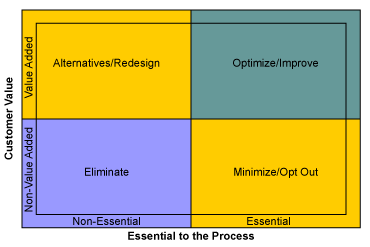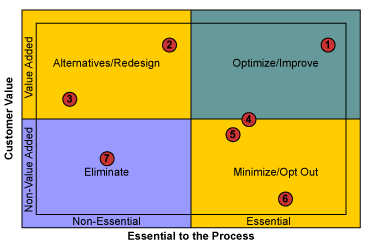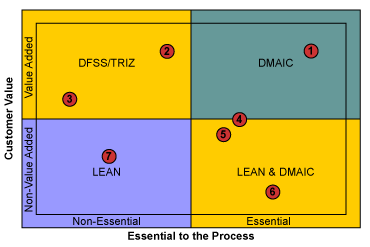
As more organizations expand their efforts into multiple process improvement methodologies, choosing the methodology to solve a particular problem can be as difficult as solving the actual problem. While simply using a problem solving methodology significantly increases the success rate of a project, choosing the correct methodology optimizes the solution process to achieve the best result.
A simple tool, adapted from a marketing concept called a positioning map, can help practitioners choose the best methodology.
A Lesson from Marketing
In marketing, after segmenting a market and then targeting a consumer, the next step is to position a product within that market. When choosing a process improvement methodology, the process is much the same. First, practitioners scope the project. Then, they target the specific problem to address. The final step is choosing the best methodology to solve the problem.
When using a positioning map, marketers plot products or services in one of four quadrants so they can compare and contrast them. The map helps them evaluate the perceived attributes of their product or service, and address the reasoning for their placement of the product or service in the marketplace. This same process also is useful in choosing a problem solving methodology, as well as in allocating the appropriate resources to achieve a balance within an organization. Projects can be plotted in one of four quadrants in a positioning map, which correspond to four process improvement methodologies or roadmaps.
Using a Positioning Map
The practice of using a positioning map begins with drawing a Cartesian coordinate system and labeling each axis with the two attributes for comparison. For the process improvement methodology selection process, the two axis labels used are “Essential to the Process” and “Customer Value” (Figure 1).

The first step in using the positioning map is completing an internal-focused assessment, where practitioners determine if a potential project is essential to the process. This may mean challenging the design and methods of executing the current process steps.
When conducting this analysis exercise, it is useful to involve the process experts and others in the organization who know the history of the process. These individuals can greatly assist with answering “Why?” questions about the process. They also can assist in giving background information and documentation.
The ranking of projects in relation to the vertical axis, Customer Value, focuses on how the process output corresponds with the demands and desires of the customer. This is an external-focused assessment that makes an effort to position projects in relation to the customers’ requirements. Because this assessment focuses on the customer, using members of the marketing and sales groups within the organization is highly recommended.
The next phase in using the positioning map is to place the potential projects on the map in the area that corresponds to their relationship with the two axes (Figure 2). Process steps that are both value added to the customer and essential to the process are candidates for improvement or optimiatzation, while those that are value added but not essential to the process should be considered for redesign, and those that are non value added but essential to the process should be minimized or opted-out. Steps that are not value added and not essential to the process should be eliminated. Practitioners should evaluate their initial placement and ensure the intent of the improvement opportunity is met.

Meaning Behind the Quadrants
After practitioners agree to the placement of the projects on the positioning map, they can assign process improvement methodologies to each project in relation to the corresponding quadrant of the positioning map. The Lean methodology is used to address projects focused on non-essential and non-value-adding steps. Projects that focus on steps that are non-essential but value-adding to the customer should use a design improvement methodology such as Design for Six Sigma or TRIZ. Projects focused on improving essential and value-adding processes should be run using the traditional Six Sigma DMAIC methodology. Finally, projects focused on essential but non-value-adding processes should be completed using a combination of the Lean and DMAIC methodologies. In these projects the Lean tools help to eliminate the waste and the DMAIC tools help to optimize the performance of the process (Figure 3).

Agree on the Next Move
One key point to remember is that a positioning map is based on the perception of the group using the tool. Because perceptions are different from person to person and group to group, opinions on choosing an improvement methodology will also differ. But there should be similarities and eventual agreement.
Choosing the correct process improvement methodology is not a difficult task for full-time Six Sigma practitioners, but for other members of project prioritization teams, it is often an obstacle that takes up valuable time and energy. The positioning map is one tool that helps address this issue.